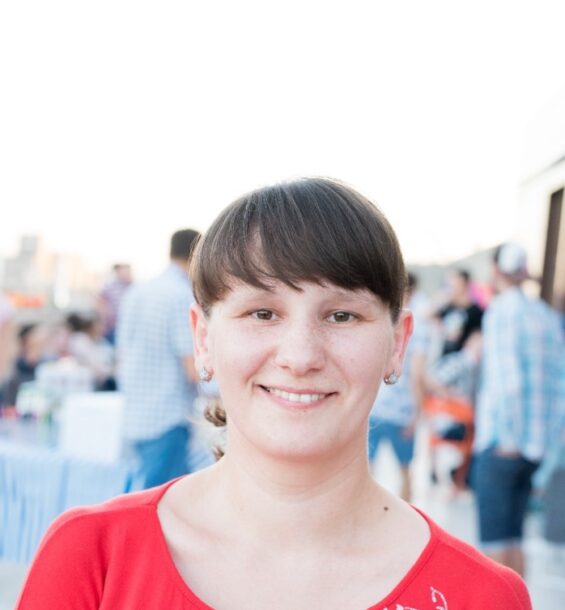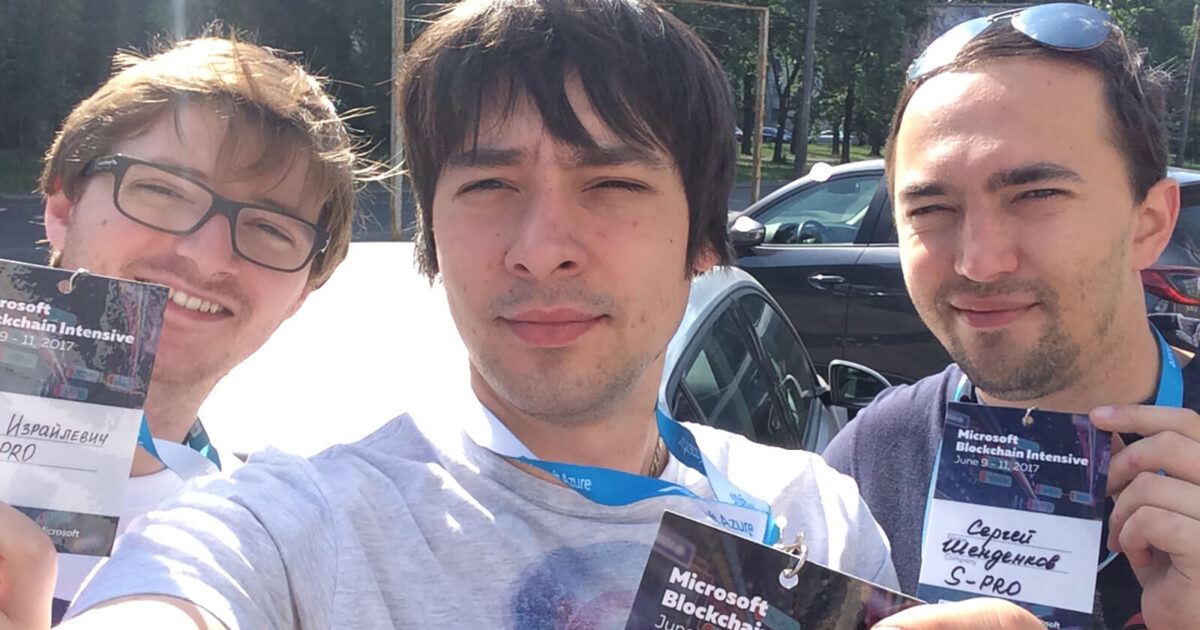Technological success of every company is possible only through a lot of sweat and blood. Not literally, of course. In this article, you’ll read about our long and hard, but fascinating and successful path to Blockchain.
This path in our company was started by Igor Izraylevych, CEO, Arseniy Burmistrov, product manager, and Sergey Shendenkov, developer. They took part in Microsoft Blockchain Intensive which was held in Kyiv in June 2017. They got a deep immersion at a hackathon. Our guys worked in a team, creatively approached the task, and became one of the event winners. As a result, one of the participants chose our achievements and hired us to develop an environmental platform based on Blockchain!
I interviewed Sergey. He told me about his progress in Blockchain, shared knowledge of this technology and its use in different business niches. So, here we go!
First Immersion
S-PRO: Which business case did you choose to develop the solution for?
Sergey: The organizers voiced three tasks. We chose a business case for electricity costs automation via Blockchain.
S-PRO: Sounds intriguing! Tell me more about it.
Sergey: Imagine a cottage village with 30 houses. It has its own source of electricity generation, solar or windy, as well as an electricity line from the outside. We needed to develop a line on Blockchain, which would allow to buy electricity from any manufacturer and to perform calculations.
Nuclear power plants produce electricity, which comes to end user through an intermediary company. A consumer pays the intermediary company for electricity and the company, in its turn, pays the manufacturer. But electricity transmission through the lines always carries a loss. It’s a complex system, as it’s difficult to estimate these losses from point A to point B. Power plants sell electricity to the wholesale market. Electricity is bought by intermediaries and transported through their lines to the consumer. Third-party companies declare the losses level. This data is almost impossible to check out. So intermediaries profit from this situation and raise tariffs.
And now imagine that it’s possible to order electricity with the help of Blockchain. The third energy package, e.g, as in Europe. One wire is carried to the house, and energy comes from where you want. It’s difficult to pay for electricity costs. If you develop a reliable and accurate accounting, where everything gets fixed, then you no longer need any intermediary company. There are smart meters at power plants and consumers. Smart contracts are guided by these counters as reliable data and make calculations that can’t be changed.
S-PRO: Who was in your project team at the hackathon?
Sergey: There were three of us from Zaporizhia, and five other guys from Kyiv.
S-PRO: Was it difficult to solve the business case?
Sergey: Yes, it was difficult for us to solve the business case. And not all team members took part in the development process. Arseniy, e.g., wasn’t involved in technical issues. One guy was a web developer, so he didn’t participate in Blockchain development, and this guy wrote a frontend page. We wanted a consumer to visit a web-page and order electricity from any NPP. We started writing code and learning what to do. At that time, our team didn’t understand what to do and tried to figure it out with the help of examples. We began by creating a web part and then started to develop a Blockchain part. Some of us were more knowledgeable in theory, and others—in practice.
We started to get something primitive. At some stages, we couldn’t understand what to do at all. Our team lacked practical knowledge and didn’t know how to implement everything completely. Now I know what’s what. And then Igor and I worked until one o’clock in the morning, trying to understand everything.
S-PRO: How did you get out of the situation?
Sergey: On the second day of Hackathon we continued solving the business case. We also didn’t really understand how all that should work. One smart contract worked by example. A web-page would work, but there were some bugs, and it was necessary to understand the issue from the side of JavaScript. We made a smart token.
There was a feeling that we couldn’t cope with the task. Mentor said that if we wanted to win, there should be a zest that distinguishes us from others. We decided to take a chance, and invented our own task!
Breakthrough
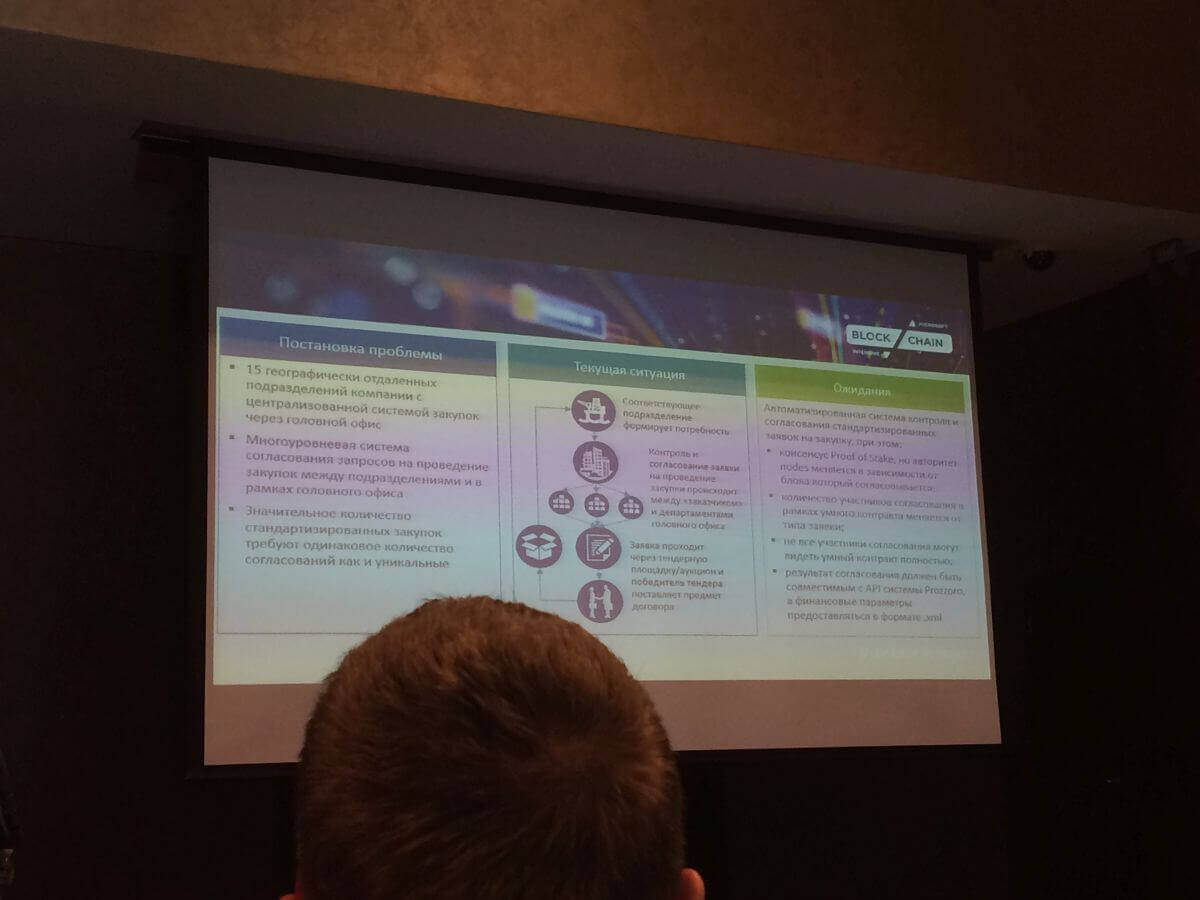
Our guys broke stereotypes and decided to solve their own business case
S-PRO: Wow! And what was that task?
Sergey: Once I watched a program on the Discovery Channel. Electric public transport was tested in South Korea It could recharge from wireless chargers. Special metal plates were built in at each bus stop. A bus could be charged during a stop, while passengers came in or out.
We began to develop our idea, but with electric cars. Imagine that there are chargers on special zones for electric cars at each traffic light, parking, etc. A driver, e.g., didn’t have time to fully charge. It’s okay! A car can be charged during a stop at the red traffic light. And no wires are needed! This solution is technically complicated and expensive. There is also an economic problem: how to conduct calculations. There is a bunch of settings, payment systems, and users. Blockchain will help here! As well as with electricity for a cottage village—a lot of manufacturers and consumers. We exclude any intermediaries with the help of Blockchain. The only owner is a city, and an electric car’s owner is the user. A smart contract will do everything, so there is no need for payment procedures via banks or any other institutions. You can set the payment settings yourself. Look! A car arrived, and a sensor fixed the charge level. You can also set special conditions in a smart contract. Do you need to charge, e.g., in this place? Or is it too expensive for you, and is it better to find a cheaper one? And if a location is too expensive for a driver, the car won’t be charged. It’s a digital economy. Blockchain helps to automate and optimize all the processes.
We made a smart token, a cryptocurrency based on Ethereum. We made the currency able to be produced and burned. We didn’t have time to finish the smart contract on mutual settlements. We also needed a frontend.
Closer to the evening we realized that we didn’t have enough technical knowledge.
S-PRO: Did you have to develop an MVP?
Sergey: No. We needed to show that the solution can work, even if it was a bunch of bugs in it. It was necessary to develop something to make MVP in the future and develop further.
S-PRO: What technologies did you use? How much time did you spend developing solutions for your business case?
Sergey: We used Dapp on Ethereum, IoT integration on C#. About 21 hours were spent.
S-PRO: How did the hackathon final pass?
Sergey: Business analysts presented our project. They explained the situation to the judges. They told the judges that we didn’t have time to fully develop the solution, but we were working on it. We have correctly drawn up the scheme and described how the mutual settlements pass. Our idea turned out to be progressive. We’ve won. But we did not believe it at first!
S-PRO: Do you keep in touch with the guys?
Sergey: Yes. We keep in touch, basically, with a couple of guys. We worked with our hackathon team member on Climate Drops Platform. S-PRO developed this app with Blockchain, and it’s already launched in some Ukrainian cities. With this platform, people can earn a certain amount of virtual coins for choosing a bicycle instead of a gasoline car, using solar panels, and warming houses. Now we are brainstorming another project together which will be based on Blockchain too.
“Trash is Cash”
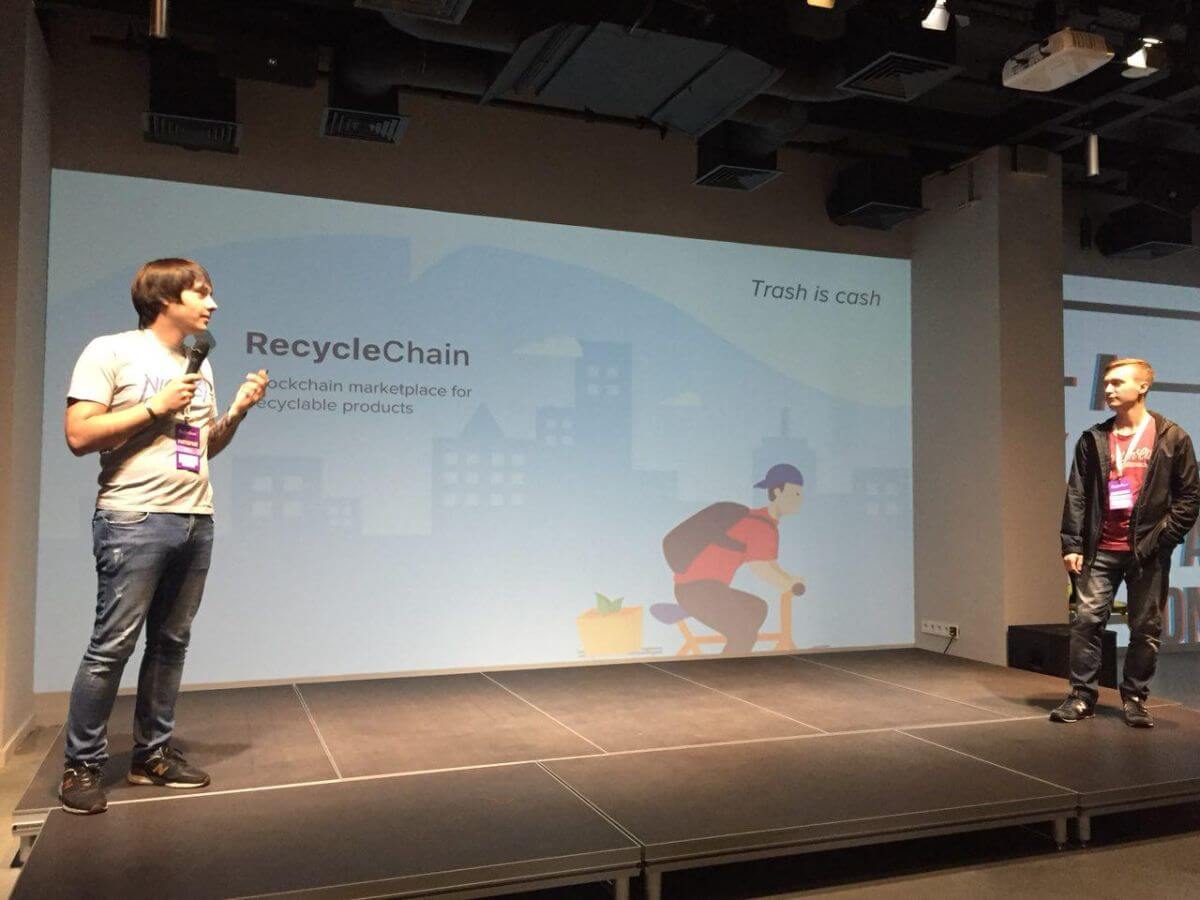
Arseniy Burmistrov on the main stage of the third all-Ukrainian Hackathon
S-PRO: What other Blockchain events did you take part in? Did you win?
Sergey: We took part in BlockchainUA conference and the third all-Ukrainian Hackathon. They were held in Kyiv in September 2017. We didn’t win, but it was a great experience for us. And the judges gave our project a positive assessment.
S-PRO: Which business case did you choose this time?
Sergey: We chose a business case connected with waste sorting, and joined the team which created this idea.
This time five of us took part in the conference and hackathon: Arseniy Burmistrov and Mykhailo Barskyi, managers, Alexander Kazantsev, middleware developer, Elena Derymova and I, Blockchain developers. Other five guys were from Kyiv and Lviv.
An app slogan was: “Trash is Cash”. The main idea was to motivate people to sort the garbage themselves and bring it to collection points or throw garbage in different tanks. You can get cryptocurrency for each type of sorted waste. It’s really possible to exchange if a point approves that you brought the correct sorted waste. In this case, a collection point will transfer bonuses. For each type of garbage, there are different tokens. A сollection point, in its turn, transfers waste to waste processing plant, which buys it for the cryptocurrency. Big enterprises can also bring waste in large volume.
S-PRO: What technologies did you use here? How much time did you spend?
Sergey: We used Ethereum, Solidity, Node.js, Koa, MySQL, web3.js, Swift/Objective-C. We spent more than 20 hours just like the first time.
S-PRO: What impressed you most about these events?
Sergey: At this hackathon, judges liked decisions related to the real iron things that can be touched. Such areas were represented as, e.g., architecture, identification, etc. We’ve learned that we shouldn’t be juggling things, as there is often not enough time. At the last hackathon, no one knew each other, and only three tasks were voiced. Now many people came with their projects, and it’s not known at what stage of readiness. At the conference, we learned more deeply about Initial Coin Offering.
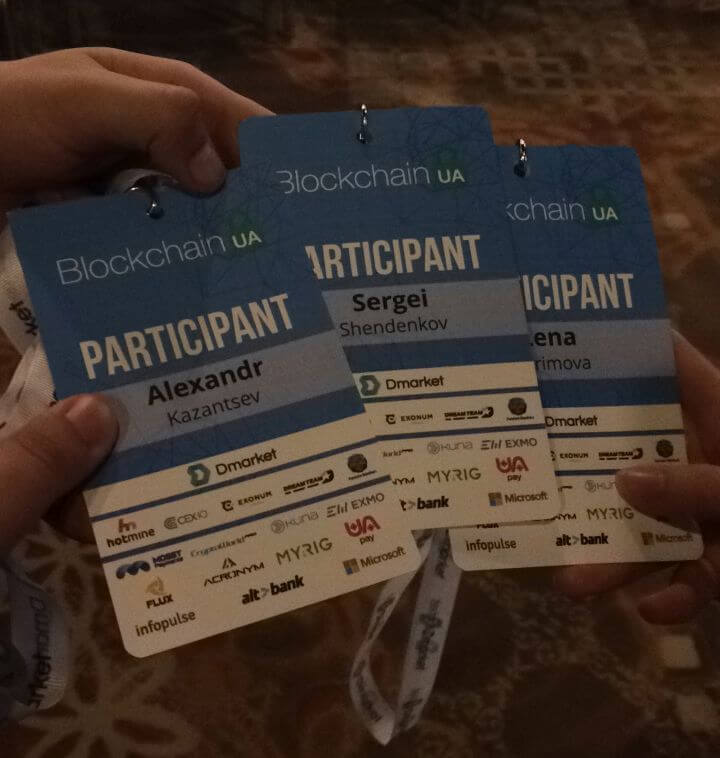
It was a cool experience. We are ready to move forward!
Conclusions
S-PRO: Share your impressions about working with Blockchain technology.
Sergey: When you read theoretical materials, you see that Blockchain is really great. This technology can literally capture the world. Almost every business processes can be automated. Labor market can be revolutionized, at least in developed countries—the professions, e.g., of lawyer or accountant may disappear.
In practice, you face a lack of training materials. All guides obsolete quickly. In June we read the March guide, and it has already become irrelevant! Blockchain is rapidly developing. Updates are often issued. All that makes Blockchain learning harder and harder. It’s always difficult to find something worthy. And when you find, it may turn out to be non-working.
When you have a deeper immersion in Blockchain, you begin to realize that this technology isn’t ideal and has limitations. And you doubt whether it will really change the world. As the technology Blockchain has already taken off. Ethereum, e.g., cost 4 cents at the beginning of 2017, and 400 USD in August! Bitcoin cost about 100 USD, and now its cost is about 5300 USD. But the cryptocurrency rate is unstable: now it has one indicator, and in a week everything can change.
To download the entire blockchain of Ethereum you need 120 GB of memory! You must pay for all changes and transactions on the Ethereum platform, only reading is free.
Blockchain allows conducting Initial Coin Offering. You can create an idea, invest in an ad, and collect a bunch of money. In May one company collected a few tens of millions of bucks in 30 seconds! In July appeared a new record holder. Some guys conducted ICO, and collected 168 million bucks in 5 days!
S-PRO: Will you continue Blockchain development?
Sergey: Yes. I want to grow further in this technology.
S-PRO: For which developers it will be easier to learn Bloсkchain?
Sergey: It will be a little bit easier to learn Blockchain for those developers, who worked with Java and C++. It’s considered that Solidity language is the mix of JavaScript and C++. The language specificity is strict typing plus objects, but this is far from JavaScript, and closer to Java. If Solidity developers allude to this, then I think that it won’t be easy for JavaScript developers to make smart contracts. But in order to work with contracts from outside, to develop a website or an app, then there are advantages for JavaScript developers, ‘cause all the commands are from their sphere.
S-PRO: Blockchain is on the wave now, but only a few people are strong in it. What advice will you give to businesses who are looking for Blockchain developers?
Sergey: You need to find an ordinary developer and train him or her. In Ukraine, as well as all over the world, different companies hold a bunch of conferences, IT-forums, hackathons, etc. You look who came, and who knows what. It’s very difficult to leave such events without finding a developer with the necessary skills for your project.
